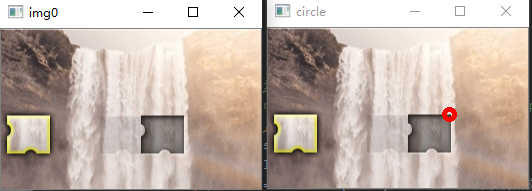基于selenium进行动作链
由于最近很多人聊到滑动验证码怎么处理,所以决定自己动手试一下。
做一个东西前。我们首先要对这个东西的操作过程有一个大概的了解。
- 打开验证码页面。
- 鼠标放到拖动按钮上
- 对拖动按钮进行拖动
- 拖动到阴影快重合的位置。
- 放开拖动按钮。
from selenium import webdriver
from selenium.webdriver.common.action_chains import ActionChains
artice = browser.find_element_by_class_name('geetest_slider_button') # 滑动按钮
action = ActionChains(browser)
action.click_and_hold(artice).perform() #按住按钮不放
action.reset_actions()
action.pause(0.01).move_by_offset(step, 0).perform() #step 为滑动的水平距离
action.release(artice).perform() # 松开按钮
上面就是本方用到的有关于ActionChains的方法。其他方法这里不过多介绍,想了解更多的请转seleniun ActionChains 鼠标键盘操作
接下来到我本次要介绍的重点,滑动距离的介绍,也就是图片求阴影区域的位置。
这里我使用了opencv库,主要流程包括
- 对图像二值化
- 对二值化的图像进行高斯模糊
- 用canny进行边缘检测
- 然后HoughLinesP霍夫变换寻找直线
- 对符合条件的直线进行处理寻找交点,进而求出我们要找的阴影快的距离
import cv2 as cv
import numpy as np
import math
# 寻找直线
def FindLines(image):
image = cv.cvtColor(image, cv.COLOR_BGR2GRAY) # 二值化
blurred = cv.GaussianBlur(image, (5, 5), 0) # 高斯模糊
canny = cv.Canny(blurred, 200, 400) # canny边缘检测
lines = cv.HoughLinesP(canny, 1, np.pi / 180, 20, minLineLength=15, maxLineGap=8) # 霍夫变换寻找直线
return lines[:, 0, :] # 返回直线
# 这里对直线进行过滤
def FindResultLises(lines):
resultLines = []
for x1, y1, x2, y2 in lines:
if (abs(y2 - y1) < 5 or abs(x2 - x1) < 5) and min(x1, x2) > 60: # 只要垂直于坐标轴的直线并且起始位置在60像素以上
resultLines.append([x1, y1, x2, y2])
return resultLines
# 判断点是否在直线上
def distAbs(point_exm, list_exm):
x, y = point_exm
x1, y1, x2, y2 = list_exm
dist_1 = math.sqrt(abs((y2 - y1) + (x2 - x1) + 1)) # 直线的长度
dist_2 = math.sqrt(abs((y1 - y) + (x1 - x) + 1)) + math.sqrt(abs((y2 - y) + (x2 - x) + 1)) # 点到两直线两端点距离和
return abs(dist_2 - dist_1)
# 交点函数 y = kx + b 求交点位置
def findPoint(line1, line2):
poit_status = False
x1, y1, x2, y2 = line1
x3, y3, x4, y4 = line2
x = y = 0
if (x2 - x1) == 0: # 垂直x轴
k1 = None
b1 = 0
else:
k1 = 1.0 * (y2 - y1) / (x2 - x1)
b1 = y1 * 1.0 - k1 * x1 * 1.0
if (x4 - x3) == 0:
k2 = None
b2 = 0
else:
k2 = 1.0 * (y4 - y3) / (x4 - x3)
b2 = y3 * 1.0 - k2 * x3 * 1.0
if k1 is None:
if not k2 is None:
x = x1
y = k2 * x1 + b2
poit_status = True
elif k2 is None:
x = x3
y = k1 * x3 + b1
poit_status = True
elif k1 != k2:
x = (b2 - b1) * 1.0 / (k1 - k2)
y = k1 * x * 1.0 + b1 * 1.0
poit_status = True
return poit_status, [x, y]
# 求交点
def linePoint(resultLines):
for x1, y1, x2, y2 in resultLines:
for x3, y3, x4, y4 in resultLines:
point_is_exist, [x, y] = findPoint([x1, y1, x2, y2], [x3, y3, x4, y4]) # 两线是否有交点
if point_is_exist:
dist_len1 = distAbs([x, y], [x1, y1, x2, y2])
dist_len2 = distAbs([x, y], [x3, y3, x4, y4])
if dist_len1 < 5 and dist_len2 < 5: # 如果误差在5内我们认为点在直线上
# 判断交点在行直线中是左端点还是右端点
if abs(y2 - y1) < 5:
# x1是行直线
if abs(x1 - x) + abs(y1 - y) < 5: # 左端点
return -1, [x, y]
else:
return 1, [x, y]
else:
# x2是行直线
if abs(x3 - x) + abs(y3 - y) < 5:
return -1, [x, y]
else:
return 1, [x, y]
return 0, [0, 0]
if __name__ == '__main__':
img = cv.imread(r'C:\Users\Administrator\Desktop\opencv\temImg.png')
lines = FindLines(img)
lines = FindResultLises(lines)
L_or_R, point_x = linePoint(lines) # L_or_R 用于判断交点在行直线左边还是右边 后面拖动要用到
xoffset = point_x[0]
yoffset = point_x[1]
cv.circle(img, (int(xoffset), int(yoffset)), 5, (0, 0, 255), 3)
cv.imshow('circle', img)
cv.waitKey(0)
cv.destroyAllWindows()


效果图
当然也有操作不到的图片,各位有兴趣的可以尝试并且修改其中的参数
滑动验证码
在上面我们已经找到了边缘点,并且根据交点是在左边还是右边进行计算,找到我们要滑动的最后值
if L_or_R == 1: x_offset = xoffset - 20 # 20是阴影快一半的长度 可根据实际情况调整 else: x_offset = offset + 20
有了滑动距离,接下来就应该是滑动了
如果我们直接用 action.move_by_offset(x_offset,0).perform() 图片会图示被怪物吃了。那就是运动轨迹被检测到不是正常人的行为,因为正常人很难一拉就拉到对应的位置。
滑动轨迹算法
所以我们还要有一个模拟人的正常操作的拖动轨迹:下面是以先加速再减速的轨迹
import ramdom # 通过加速减速模拟滑动轨迹 def moveTrack(xoffset): updistance = xoffset*4/5 t = 0.2 v = 0 steps_list = [] current_offset = 0 while current_offset<xoffset: if current_offset<updistance: a = 2 + random.random() * 2 else: a = -random.uniform(12,13) vo = v v = vo + a * t x = vo * t + 1 / 2 * a * (t * t) x = round(x, 2) current_offset += abs(x) steps_list.append(abs(x)) # 上面的 sum(steps_list) 会比实际的大一点,所以再模拟一个往回拉的动作,补平多出来的距离 disparty = sum(steps_list)-xoffset last1 = round(-random.random() - disparty, 2) last2 = round(-disparty-last1, 2) steps_list.append(last1) steps_list.append(last2) return steps_list
有了轨迹 steps_list 我们就可以通过循环来拖动按钮。需要注意的一点是 每一次循环都要action.reset_actions() 不然他会把之前的距离也算进来,循环结束记得松开按钮
for step in steps_list: action.reset_actions() action.pause(0.01).move_by_offset(step, 0).perform() action.release(artice).perform()
到此这篇关于基于opencv的selenium滑动验证码的实现的文章就介绍到这了,更多相关opencv selenium滑动验证码内容请搜索自学编程网以前的文章或继续浏览下面的相关文章希望大家以后多多支持自学编程网!

- 本文固定链接: https://zxbcw.cn/post/191625/
- 转载请注明:必须在正文中标注并保留原文链接
- QQ群: PHP高手阵营官方总群(344148542)
- QQ群: Yii2.0开发(304864863)
